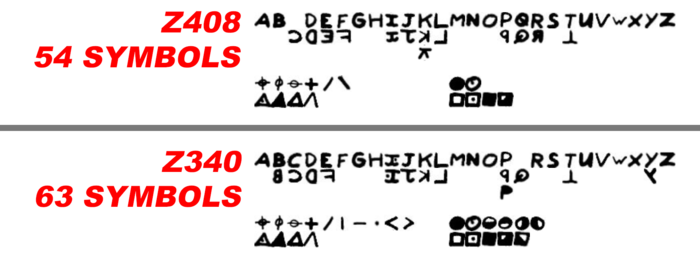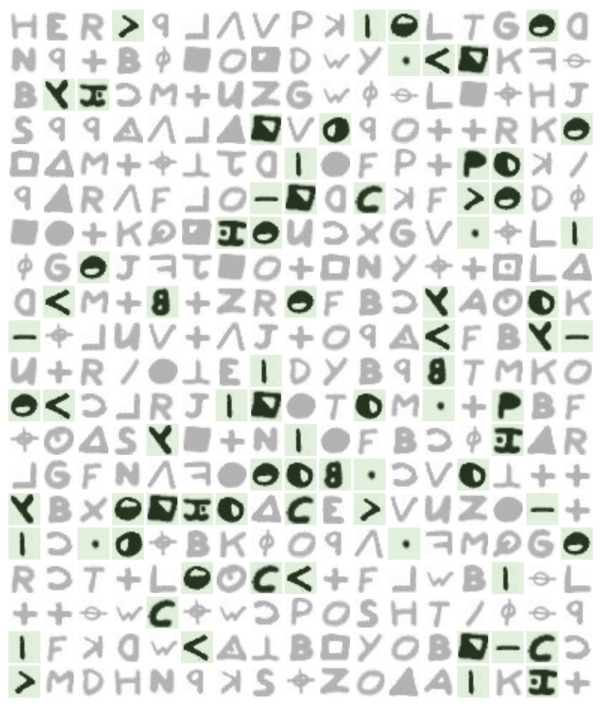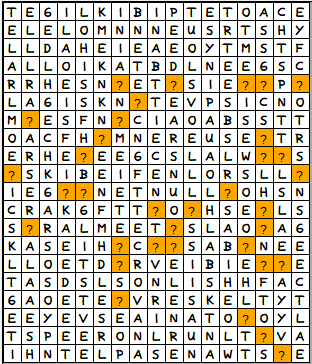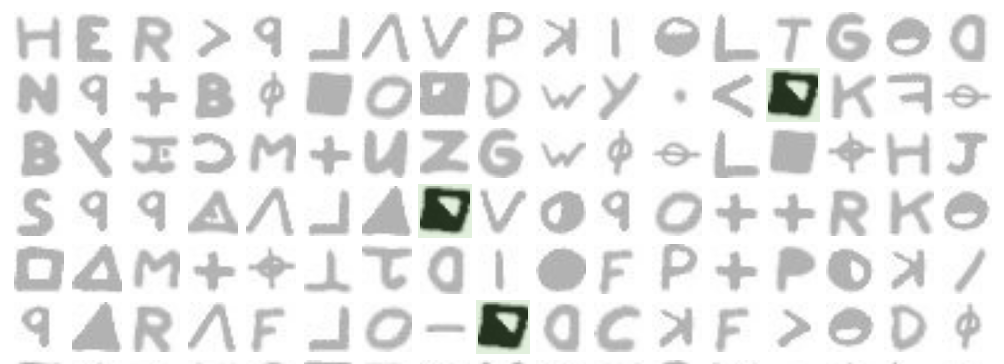I noticed the following: If you apply the key from z408 to z340, the first four lines and the beginning of the fifth line do not contain any missing symbols. In other words, the first 74 characters do not contain any of the symbols added in z340. The following picture illustrates this:
To check how often something like this happens by chance, I did a shuffle test with 10 million runs. For each shuffle I counted the longest sequence that didn’t contain any of the new symbols. The probability of a sequence of 74 or more characters is 0.39%. I don’t know if that means anything yet but I found it interesting.
@smokie:
That reminds me a little of the Alberti method you presented. Maybe 5 * 4 lines with different keys? However, this does not explain the pivots or P15/P19.
Interesting observation Largo.
An explanation could be that Zodiac reused the symbols of the 408 in the making of the 340 key (either before or during the encoding process) and when all of these symbols were used he decided to add 9 more homophones to the key (perhaps because he realized he made a very inefficient key).
That is very interesting, and so is Jarlve’s theory. I never thought to make a map of the new symbols like that. I wonder if manipulations of the new symbols map, like redrafting into different numbers of columns or untransposing would reveal a pattern. I think that the probability of 0.39% seems important. It is nice to have someone new with fresh ideas. Good thinking!!!
EDIT: I drafted the message into 2 columns through 85 columns and did not see any interesting patterns.
EDIT 2: It seems likely, but not for sure, that Zodiac put together a key starting with the symbols from the 408, then decided to add more symbols at the ends of each group of homophonic assignments to diffuse the plaintext a bit more. Then when he cycled through the homophonic assignments, he came to the new symbols where you show them. ?
I like your hypothesis Jarlve, its very plausible. This would be a further indication that the homophonic substitution was performed ltr, ttb after a possible transposition and not before. (We already have a lot of hints, like the rows without repetition and so on). If the new symbols have been added to the key after the first 4-5 rows have been encrypted, we should be able to find more information in the first rows. For example, better values for cyclic repetitions that disperse from row 5 or 6.
smokie: By the redrafting of the key, do you mean that the plain text letters have been moved? Like this, for example:
Key 408
A: 1, 2 B: 3, 4, 5, 6 C: 7, 8, 9
Key 340
B: 1, 2 C: 3, 4, 5, 6 A: 7, 8, 9
Maybe he just reversed the plaintext alphabet? If he’s done something like this, there must be some clues. I will see how I can write an automated test.
But one thing makes me wonder:
If Zodiac has actually performed a transposition before the substitution, why should he be concerned with optimizing the key? At the time, he could have been reasonably sure that it would not be possible to manually solve a transposed, homophonic encryption.
smokie: By the redrafting of the key, do you mean that the plain text letters have been moved? Like this, for example:
Key 408
A: 1, 2 B: 3, 4, 5, 6 C: 7, 8, 9Key 340
B: 1, 2 C: 3, 4, 5, 6 A: 7, 8, 9hould he be concerned with optimizing the key? At the time, he could have been reasonably sure that it would not be possible to manually solve a transposed, homophonic encryption.
Yes, I suppose. If you are talking about two posts above, I meant redrafting the 340 into 2 columns, 3 columns, 19 columns, etc., to see if there is a pattern with the ? symbol.
Maybe he just reversed the plaintext alphabet? If he’s done something like this, there must be some clues. I will see how I can write an automated test.
But one thing makes me wonder:
If Zodiac has actually performed a transposition before the substitution, why should he be concerned with optimizing the key? At the time, he could have been reasonably sure that it would not be possible to manually solve a transposed, homophonic encryption.
Yes, I agree. If he transposed the plaintext, then why bother with even using polyphones, an Alberti disk, or whatever. And why use 63 symbols when probably much fewer would have been sufficient to baffle us for at least a couple of decades. Welcome to the 340, I think one of the strangest mysteries and so full of details. I am really glad that we have a new imagination working with us.
If he transposed the plaintext, then why bother with even using polyphones, an Alberti disk, or whatever. And why use 63 symbols when probably much fewer would have been sufficient to baffle us for at least a couple of decades. Welcome to the 340, I think one of the strangest mysteries and so full of details. I am really glad that we have a new imagination working with us.
I admit, I’m a little confused right now. I didn’t want to pretend that z340 is totally easy and still nobody was able to solve it. Honestly, I don’t know if I just offended you unintentionally and your post was sarcastic ![]() . If so, then I would like to make it clear that I’m just looking for possibilities. An error in a simple transposition can make the whole thing impossible to solve. The fact that z340 remained unresolved for decades does not mean that it is a cryptological masterpiece.
. If so, then I would like to make it clear that I’m just looking for possibilities. An error in a simple transposition can make the whole thing impossible to solve. The fact that z340 remained unresolved for decades does not mean that it is a cryptological masterpiece.
If I have offended you in any way, I apologize for that. If not, my limited English language skills played a trick on me ![]()
You must misunderstand something Largo, smokie means no bad.
My thoughts are that questions such as, Why did he do this? Why did he do that? do not much help us forward in any way. I rather find out what is real or most likely. I really like this observation of yours Largo and it is very much on my mind.
I agree with Jarlve; Smokie was not offended, he was just thinking out loud, speculating about Zodiac’s intentions. Something must have gotten lost in translation!
Nice work with the discovery of this observation! I have only one small quibble: The observation holds up only if you consider  (from Z408) to be the same symbol as
(from Z408) to be the same symbol as  (from Z340). It may be fair to treat them equally, since there is no
(from Z340). It may be fair to treat them equally, since there is no  in Z340 (except for the dotted variants). But
in Z340 (except for the dotted variants). But  appears in the first line of Z340.
appears in the first line of Z340.
Unfortunately I might have found another problem –
If I’m not mistaken (please check this), Z340’s left filled square is not in Z408 but appears on lines 2 and 4:
I think you have it as "T" in your plaintext version of Z340. Which symbol did you use there?
BTW here’s a visual symbol comparison I did recently:

Yeah, I was just thinking out loud. Not one brain cell in my head was offended. All I want is to keep working on it and find a solution, like a machine. We will not always agree on things, but have a common interest and that is what keeps us together. That said, would you happen to have an updated map of where all the "new" symbols are?
How many ways can we look at the "new" symbols to try to find a clue?
That said, would you happen to have an updated map of where all the "new" symbols are?
Here’s what I’ve got if you want to compare notes:

Well, there goes the observation. Thank you doranchak for pointing that out.
Largo: use the webtoy transcriptions.
9%P/Z/UB%kOR=pX=B WV+eGYF69HP@K!qYe MJY^UIk7qTtNQYD5) S(/9#BPORAU%fRlqE k^LMZJdrpFHVWe8Y @+qGD9KI)6qX85zS( RNtIYElO8qGBTQS#B Ld/P#B@XqEHMU^RRk cZKqpI)Wq!85LMr9# BPDR+j=6N(eEUHkF ZcpOVWI5+tL)l^R6H I9DR_TYrde/@XJQA P5M8RUt%L)NVEKH=G rI!Jk598LMlNA)Z(P zUpkA9#BVW+VTtOP ^=SrlfUe67DzG%%IM Nk)ScE/9%%ZfAP#BV peXqWq_F#8c+@9A9B %OT5RUc+_dYq_^SqW VZeGYKE_TYA9%#Lt_ H!FBX9zXADd7L!=q _ed##6e5PORXQF%Gc Z@JTtq_8JI+rBPQW6 VEXr9WI6qEHM)=UIk HER>pl^VPk|1LTG2d Np+B(#O%DWY.<*Kf) By:cM+UZGW()L#zHJ Spp7^l8*V3pO++RK2 _9M+ztjd|5FP+&4k/ p8R^FlO-*dCkF>2D( #5+Kq%;2UcXGV.zL| (G2Jfj#O+_NYz+@L9 d<M+b+ZR2FBcyA64K -zlUV+^J+Op7<FBy- U+R/5tE|DYBpbTMKO 2<clRJ|*5T4M.+&BF z69Sy#+N|5FBc(;8R lGFN^f524b.cV4t++ yBX1*:49CE>VUZ5-+ |c.3zBK(Op^.fMqG2 RcT+L16C<+FlWB|)L ++)WCzWcPOSHT/()p |FkdW<7tB_YOB*-Cc >MDHNpkSzZO8A|K;+
Yeah, I was just thinking out loud. Not one brain cell in my head was offended.
I’m glad to hear that. I had some exhausting days and so I had just misinterpreted your statement.
My thoughts are that questions such as, Why did he do this? Why did he do that? do not much help us forward in any way. I rather find out what is real or most likely.
We will not always agree on things, but have a common interest and that is what keeps us together
Working with different approaches is the best thing we can do. I like to work with the approach "Why did he do this and that?" I’d like to put 100 people in a room who have never been involved with encryption before. Then I would explain how z408 works and how it was cracked. After that, I would give these 100 people the task of finding an improved encryption method that can’t be cracked so quickly. Just to see what ideas they have. I did this once with some friends. One of them came up with the idea that each encryption symbol could stand for several plain text letters… polyphonic! He was not aware that he had created nearly a one-time-pad with it. Someone else simply wrote the text backwards.
David:
Thanks for the comparisons. I’m just seeing that I messed up. Instead of visually comparing, I simply relied on my long-established transcriptions and keys and overlooked the fact that they don’t fit together (z408 and the z408 key fits, z340 transcription is ok too. But z408 key and z340 cipher does not share the same symbol assignments). Already the fourth character (<) does not appear in z408. So my "discovery" is pretty worthless. Nevertheless, I will spend some time with the key of z408 and the distribution of the new symbols. Maybe I’ll notice something after all.
Working with different approaches is the best thing we can do.
I agree but some approaches may be exhausted.


